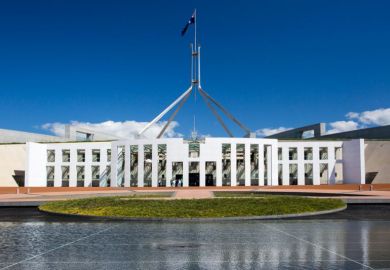Australian universities would receive “core” additional funding to cover the substantial extra costs of educating disadvantaged and regional students, under recommendations from a landmark review.
The government would cover full teaching costs, bringing in a needs-based funding model that would “effectively introduce ‘demand-driven places for equity students’”.
The new model would be a “game-changer” for regional institutions, which would also receive more funded places for medical students. The regional study hubs programme would be expanded to increase rural Australians’ participation, retention and completion rates, while ongoing consideration would be given to a national regional university.
Australia would also move towards full funding of research, with government and industry paying the whole cost of consultancies and studies they commissioned from universities. Funding for research overheads would be increased to 50 cents for every dollar of grant money – up from about 22 cents now – with the increased target to be reviewed every five years.
A “multi-agency government strategy” would be formulated to increase the proportion of gross domestic product invested in research and development. The Australian Research Council (ARC) would receive additional funding to support fundamental research, and a new “Solving Australia’s Challenges Fund” would “reward” universities that used their research firepower effectively and applied it to “big national challenges”.
The proposals are among 47 recommendations in the 408-page final report of the Australian Universities Accord Panel, released publicly on 25 February. The federal government’s response to the report is expected on 27 February, when education minister Jason Clare addresses the Universities Australia conference in Canberra.
“To be successful, these reforms will require a large investment from the Australian government and a major contribution from higher education providers,” the report says. “All parts of Australia’s education system need to work together to meet [our] future skills challenge.”
The report recommends a target of 80 per cent of working-age people holding tertiary qualifications by 2050, up from 60 per cent today. A separate target would see 55 per cent of Australians aged between 25 and 34 possessing university qualifications, up from the current 45 per cent.
This would require the number of government-subsidised students to more than double to 1.8 million by 2050. The report estimates that the tally will reach only 1.1 million by mid-century under current policy settings.
“It’s a very ambitious piece of work,” said University of Technology Sydney vice-chancellor Andrew Parfitt. “It’s a major sector change agenda if it’s adopted in full – a really nice road map about what could be achieved if we put our minds to it.
“It’s going to take a lot of work to get to the implemented stage, but I think the ambition is something that we can all be up for. It will have to be done…in a very sophisticated way to make sure that unintended consequences don’t flow.”
The report presents a long-term plan for reform. Details would largely be referred to an Australian Tertiary Education Commission, whose prominent role earns it 82 mentions in the report.
The commission would provide “leadership and stewardship” for the sector. Its initial remit would include policy development, planning, pricing, funding allocation, data collection, accountability and negotiation of “mission-based compacts” with individual universities.
The commission would report to both the education and skills ministers, improving alignment between higher and vocational education. The ARC and the Tertiary Education Quality and Standards Agency would be independent statutory bodies under the commission’s “umbrella”, with their chairs made ex-officio commissioners of the proposed body while retaining their legislated roles.
As widely expected, the report has also recommended a mechanism to redistribute resources among universities. The “Higher Education Future Fund” would be managed by a board of guardians and funded by co-contributions from universities and the federal government, with the aim of reaching A$10 billion (£5.2 billion) in assets.
The fund’s earnings could be invested in learning and teaching infrastructure and affordable accommodation for domestic students. “The specific infrastructure needs of regional universities have to be addressed,” the report notes. Universities would contribute a percentage of their “untied own source, non-government revenue…those universities with the financial means to pay a higher proportion should be expected to do so”.
The report says the proposed nest egg could replace the Education Investment Fund (EIF), whose 2019 closure deprived the sector of “dedicated government funding for general teaching and research infrastructure projects”. The EIF’s demise began when the then Labor government began raiding its capital during an economic downturn about 15 years ago, and was guaranteed after the Liberal-National coalition regained power in 2013 and decided to close it the next year.
The Regional Universities Network said infrastructure funding was of “vital importance”, but any new fund must not suffer the EIF’s fate – particularly if universities were required to contribute from their private revenue sources. “What are the safeguards?” asked executive director Alec Webb. “That bit of detail is probably as important as the establishment of the fund.”
The report also recommends reforms to the student loan scheme, financial support, indigenous representation and international education, among other areas.
john.ross@timeshighereducation.com
Universities Accord: key proposals
- Needs-based funding for university teaching
- Improvements to research funding
- Australian Tertiary Education Commission
- Higher Education Future Fund
- 55 per cent attainment target
- Fee-free preparatory courses
- Overhaul of student loan scheme
- Youth Allowance and Tertiary Access Payment reforms
- Payment for compulsory placements
- Increased PhD stipend
Register to continue
Why register?
- Registration is free and only takes a moment
- Once registered, you can read 3 articles a month
- Sign up for our newsletter
Subscribe
Or subscribe for unlimited access to:
- Unlimited access to news, views, insights & reviews
- Digital editions
- Digital access to THE’s university and college rankings analysis
Already registered or a current subscriber? Login








